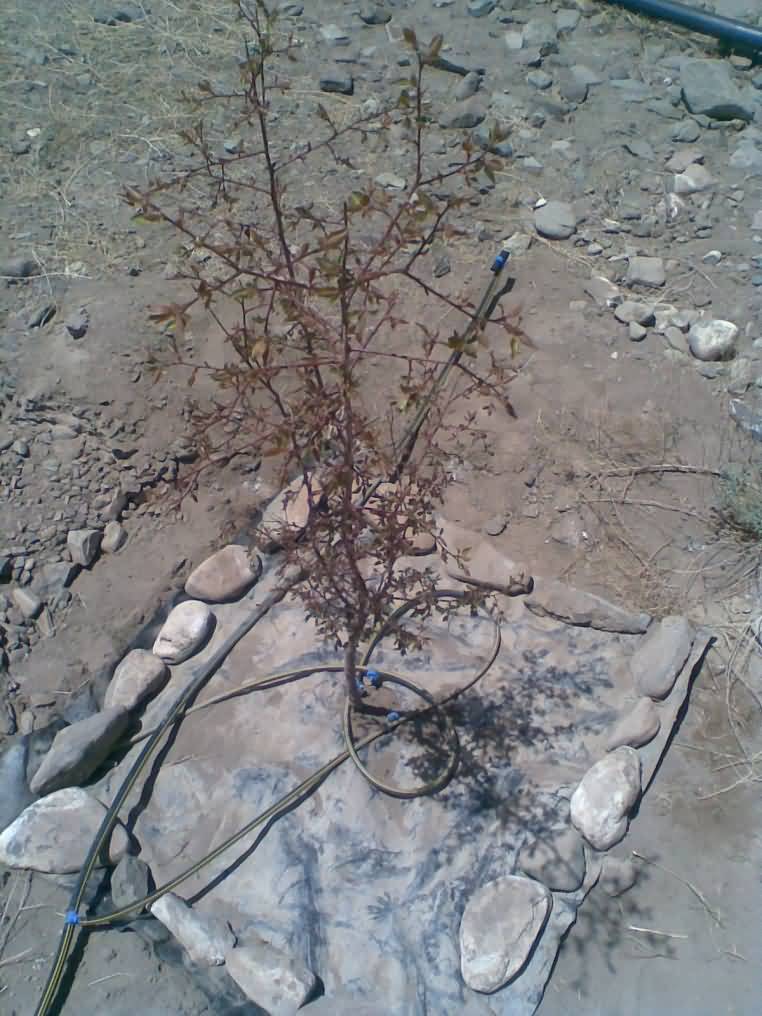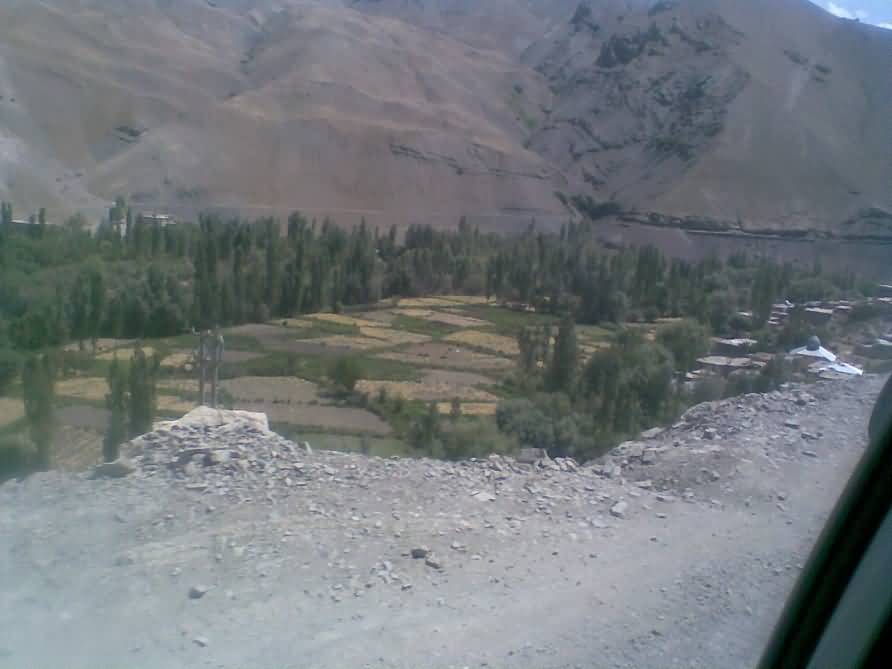शीत शुष्क कृषि के लिए एक संभावित माइक्रो सिंचाई प्रणाली - ड्रिप सिंचाई
Agriculture sector is considered as the back bone of Indian economy contributing directly and indirectly to the growth and development of our country. Since independence our country has attained significant achievements standing self sufficient in food grain production. The achievement is because of the scientific technological interventions and the utilization of the available natural resources which were in abundance. Hence Irrigation water availability predominantly being the major contributing factor in this regard.
With the advancement in the agriculture sector, it now becomes imperative to utilize the available natural wealth of resources in a manageable way for sustaining agricultural production and productivity. Efficient utilization of water resources forms the basis of survival of the ever increasing population of our country.
Ladakh region of India is a cold arid desert placed on high altitudes with scarce water resources, high evapo-transpirational losses, harsh dry winds, and totality of climatic conditions harsh and tough, hindering the agricultural advancement(Fig.1). The annual precipitation is between 100 to 150 mm, quite inadequate to meet the average moisture requirements of the crop plants. Thus supplementary irrigation becomes essential to raise the food crops. The only source of available irrigation water available is the glaciers placed on high altitudes which melt and flow during summer season. This available natural resource needs scientific management strategy to ensure sustainable and economic crop production.
With the advancement in the agriculture sector, it now becomes imperative to utilize the available natural wealth of resources in a manageable way for sustaining agricultural production and productivity. Efficient utilization of water resources forms the basis of survival of the ever increasing population of our country.
Ladakh region of India is a cold arid desert placed on high altitudes with scarce water resources, high evapo-transpirational losses, harsh dry winds, and totality of climatic conditions harsh and tough, hindering the agricultural advancement(Fig.1). The annual precipitation is between 100 to 150 mm, quite inadequate to meet the average moisture requirements of the crop plants. Thus supplementary irrigation becomes essential to raise the food crops. The only source of available irrigation water available is the glaciers placed on high altitudes which melt and flow during summer season. This available natural resource needs scientific management strategy to ensure sustainable and economic crop production.
Irrigation
Application of water by artificial means to meet the partial evapo-transpirational requirements is called irrigation. In Ladakh, irrigation water is a costly and scarce input, therefore it is essential to optimize the use of water according to availability on sustainable basis and to allow minimum water losses by efficient water management techniques.
Application of water by artificial means to meet the partial evapo-transpirational requirements is called irrigation. In Ladakh, irrigation water is a costly and scarce input, therefore it is essential to optimize the use of water according to availability on sustainable basis and to allow minimum water losses by efficient water management techniques.
Micro Irrigation System
Micro irrigation system is panacea in irrigation related problems. In this irrigation system water is applied in the vicinity of the crop plants without losses. It reduces irrigation water losses occurring through evaporation, conveyance, and distribution; therefore high water use efficiency can be achieved. The use of micro-irrigation technologies could become a potential source for food production in arid high altitude desert agro-ecosystem of Ladakh.
Potential Micro - Irrigation Systems for Ladakh Region
The micro-irrigation systems may vary with the type of crop selected, climatic conditions prevailing in the area, topography and the amount of water available for irrigation. Drip irrigation system; apotential micro-irrigation systems for cold arid region is being discussed in the article.
The micro-irrigation systems may vary with the type of crop selected, climatic conditions prevailing in the area, topography and the amount of water available for irrigation. Drip irrigation system; apotential micro-irrigation systems for cold arid region is being discussed in the article.
Drip Irrigation System
Drip irrigation functions as its name suggests, the water is applied near the root zone of the plants drop by drop. This system has been proved as the most water saving and easy micro-irrigation technology for efficient water utilization in areas of scarcity. The unique feature which favours its applicability for Ladakh region is the water use efficiency that is achieved with this technology. This has been proved to increase the economics and yield of vegetable crop (Cabbage) and the work under PFDC is being carried out to workout its applicability in other horticultural crops(Apricot).
Drip irrigation functions as its name suggests, the water is applied near the root zone of the plants drop by drop. This system has been proved as the most water saving and easy micro-irrigation technology for efficient water utilization in areas of scarcity. The unique feature which favours its applicability for Ladakh region is the water use efficiency that is achieved with this technology. This has been proved to increase the economics and yield of vegetable crop (Cabbage) and the work under PFDC is being carried out to workout its applicability in other horticultural crops(Apricot).

Layout and Design of Drip Irrigation System
Drip irrigation system is laid out as per the type of crop and recommended spacing. The value is opened and the water flows through pressure regulator in to the filter. The main function of the filter is to arrest the dirt present in the irrigation water to prevent chocking of the emitters. Water after filtration moves through the drip tubing towards the emitters placed on the laterals. The emitters place the water in the root zones drop by drop. The laterals are laid out as per the crop spacing requirements, e,g, the vegetable field needs a spacing in centimeters while as the spacing in the fruit orchards comes in meters. The emitters in the laterals are fixed on the required distance. The drip irrigation can be run both on gravity by placing the storage tank above the ground level or it can be atomized with an electric motor. The water is applied at an appropriate time preferably during the morning or evening hours for a fixed time as per the standardized requirements.
Drip irrigation system is laid out as per the type of crop and recommended spacing. The value is opened and the water flows through pressure regulator in to the filter. The main function of the filter is to arrest the dirt present in the irrigation water to prevent chocking of the emitters. Water after filtration moves through the drip tubing towards the emitters placed on the laterals. The emitters place the water in the root zones drop by drop. The laterals are laid out as per the crop spacing requirements, e,g, the vegetable field needs a spacing in centimeters while as the spacing in the fruit orchards comes in meters. The emitters in the laterals are fixed on the required distance. The drip irrigation can be run both on gravity by placing the storage tank above the ground level or it can be atomized with an electric motor. The water is applied at an appropriate time preferably during the morning or evening hours for a fixed time as per the standardized requirements.
Precautions
Drip irrigation systems require periodic maintenance throughout the growing season. These activities may require system operation during the starting period to ensure that the system is ready when needed. In addition, drip irrigation systems may require periodic maintenance to prevent clogging and system failure. Typically, cleaning agents are injected weekly, but in some instances more frequent injections are needed.
Drip irrigation systems require periodic maintenance throughout the growing season. These activities may require system operation during the starting period to ensure that the system is ready when needed. In addition, drip irrigation systems may require periodic maintenance to prevent clogging and system failure. Typically, cleaning agents are injected weekly, but in some instances more frequent injections are needed.
Advantages of drip irrigation:
- Drip irrigation provides the advantage of minimizing the nutrient losses which occur due to runoff and leaching common due to flood irrigation more common in the soils of Ladakh.
- High water use application efficiency is achieved.
- This system can be applied on the undulated and uneven fields without the requirement of leveling; more particularly in fruit crops. Most of the plantation of fruits in the region is on undulated land.
- The moisture content in the root zones is maintained in a balanced manner leading to efficient and economic production and productivity. This creates a balance in the evaporational loses and the minimum essential water requirement of the crop.
- Soil erosion of top fertile soil caused otherwise due to flooding is minimized, hence helps in efficient nutrient utilization and their management.
- The irrigation water is uniformly distributed in the root zones of the plants.
- Fertigation techniques can be applied for quick and economic fertilizer usage and sustainable availability of nutrients.
- The risk of disease prevalence and pathogen attack is minimized which otherwise frequently occur due to water logging and contact of foliage with the water.
- It reduces input costs otherwise utilized in various cultural operations like weeding, watering and other practices.
Limitations in drip irrigation
- Drip irrigation system possesses some limitations which are being presented as follows so as to provide a clear cut understanding of its all aspects.
- Initial costs in the installation of drip irrigation system are very high, because of the fact that the marginal and small farmers are unable to effort it.
- It requires technical expertise on the part of the installation and management in case of the farmers who are mostly illiterate and have least access to resources and awareness on part of its management.
- The frequent clogging and chocking of the pipes and emitters in certain cases becomes hectic to manage.
- It needs regular vigil for its proper functioning.

Strategies for promotion of Drip irrigation in Ladakh region
In Ladakh, drip irrigation could be promoted through research demonstrations and implementing various awareness cum training programmes on mass level. Presently the Precision Farming Development Centre Leh Ledakh (SKUAST-K) is working on the standardization practices of drip irrigation for potential crops and simultaneously working to promote the same through print media, trainings and demonstrations.
In Ladakh, drip irrigation could be promoted through research demonstrations and implementing various awareness cum training programmes on mass level. Presently the Precision Farming Development Centre Leh Ledakh (SKUAST-K) is working on the standardization practices of drip irrigation for potential crops and simultaneously working to promote the same through print media, trainings and demonstrations.
Authors:
P Ishfaq Akbar
Precision Farming Development Centre
Regional Agricultural Research Station (SKUAST-K)
